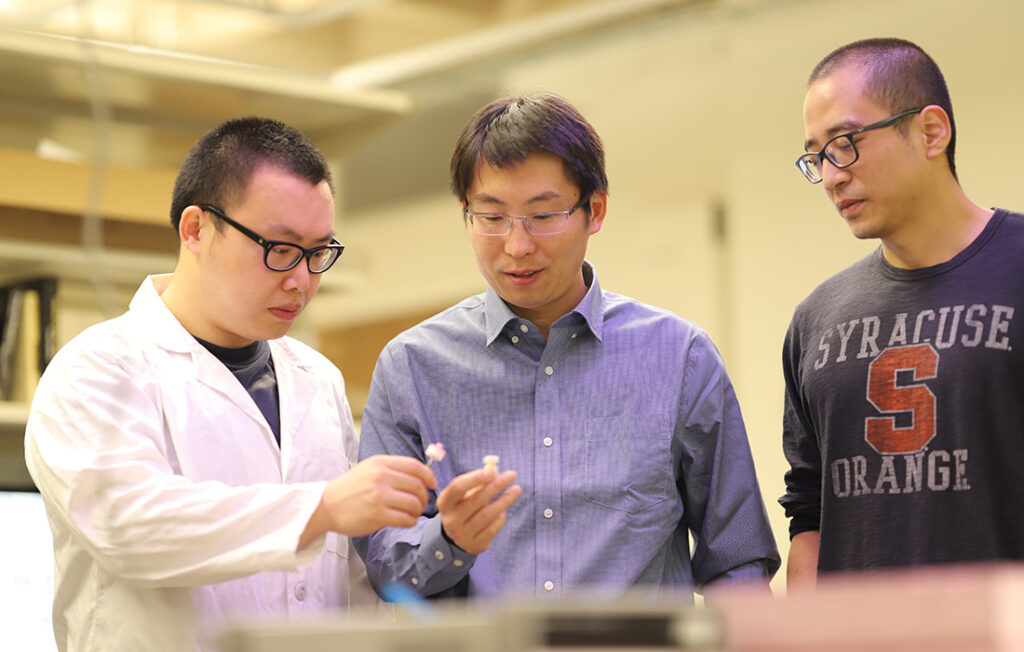James H. (Jay) Henderson, professor of biomedical and chemical engineering in the College of Engineering and Computer Science, has been appointed as director of the Syracuse University BioInspired Institute, Duncan Brown, vice president for research, has announced. Continue Reading
News
BioInspired Awards Two Cross-Institutional Project Grants
Syracuse University’s BioInspired Institute has awarded a new round of intramural grants to two interdisciplinary, cross-institutional research projects.
One project looks at how polar fungi physically adapt to survive in extreme climate environments. Its researchers are working to determine how the fungi copy and transfer DNA code at the genetic, molecular, biophysical, cellular and organismal levels.
The second project examines how shape-memory polymers react to both synthetic and biological stimuli and how various treatments affect the materials’ makeup and characteristics. The research team is studying the processes organisms use to successfully adjust their molecular structure to overcome energetic barriers. Continue Reading
Professor Wanliang Shan Receives NSF CAREER Award for Research on Tunable Adhesion

Wanliang Shan, assistant professor of mechanical and aerospace engineering at the College of Electrical Engineering and Computer Science (ECS), has received a National Science Foundation (NSF) CAREER Award to research the mechanics behind highly tunable dry adhesion for manipulating delicate and small objects. Continue Reading
Zhao Qin Recognized as International Association of Advanced Materials Fellow
Zhao Qin, assistant professor of civil and environmental engineering in the College of Engineering and Computer Science, is an International Association of Advanced Materials (IAAM) Fellow in recognition of his contribution to the advancement of materials to global excellence. He will deliver an IAAM Fellow Lecture in the Advanced Materials Lecture Series 2023. Continue Reading
Peek Into the Hidden World Inside of Cells
Using state-of-the-art equipment, biomedical scientists in the BioInspired Institute are answering some of today’s biggest questions at the microscopic level. Continue Reading
Doyle Presents New Research on Anti-Obesity Drug
An experimental anti-obesity drug could reliably curb appetite and normalize blood glucose levels without causing nausea and vomiting, which are frequent side effects of current weight-loss and diabetes drugs. Continue Reading
‘Fishing’ for Biomarkers
While a popular hobby for many, fishing is also a pastime full of uncertainty. Each time you have something on the line, you can never be completely sure what type of fish you’ve hooked until you pull it out of the water. In a similar way, scientists “fishing” for biomarkers—molecules whose health care applications include signaling for the presence of cancer—in such biofluids as blood can also encounter unpredictability. Finding a specific protein biomarker in a pool of thousands is like trying to catch a particular fish species in the vast ocean.
Luckily, a team of researchers from the College of Arts and Sciences (A&S), SUNY Upstate Medical University, Ichor Therapeutics and Clarkson University have devised a tiny, nano-sized sensor capable of detecting protein biomarkers in a sample at single-molecule precision. Fittingly coined as “hook and bait,” a tiny protein binder fuses to a small hole created in the membrane of a cell—known as a nanopore—which allows ionic solution to flow through it. When the sensor recognizes a targeted molecule, the ionic flow changes. This change in flow serves as the signal from the sensor that the biomarker has been found.
BMCE Graduate Student Yousr Dhaouadi wins 3 Minute Thesis Award
Winners of the Three Minute Thesis® (3MT) competition have been announced by the Graduate School. 3MT is a research communication competition that challenges graduate and doctoral students to deliver a compelling oration on the nature, significance and interests of their dissertation or master’s thesis research in three minutes or less. Continue Reading
Heidi Hehnly and Renée Crown University Honors Program presents ‘The Value of Beauty and Beauty in Science’
Is there beauty in science? What insights can arise from viewing scientific theories through a lens of beauty? How does such perspective bring value to individuals and society?
These are among the interdisciplinary questions to be explored at the Renée Crown University Honors Program inaugural symposium, “The Value of Beauty and Beauty in Science.” On Tuesday, April 4, a panel will engage in discussion from 2 to 4:40 p.m. in 214 Slocum Hall, followed by a reception from 4:45 to 5:45 p.m. at the Syracuse University Art Museum in the Shaffer Art Building. Continue Reading
Engineered Magic: Wooden Seed Carriers Mimic the Behavior of Self-Burying Seeds
Before a seed can grow into a tree, flower or plant, it needs to successfully implant itself in soil – a delicate and complex process. Seeds need to be able to take root and then remain protected from hungry birds and harsh environmental conditions. For the Erodium flower to implant a seed, its stalk forms a tightly wound, seed-carrying body with a long, curved tail at the top. When it begins to unwind, the twisting tail engages with the ground, causing the seed carrier to push itself upright. Further unwinding creates torque to drill down into the ground, burying the seed.
Inspired by Erodium’s magic, Mechanical and Aerospace Engineering Professor Teng Zhang worked with Lining Yao from Carnegie Mellon University (CMU) and a team of collaborators to engineer a biodegradable seed carrier referred to as E-seed. Continue Reading
